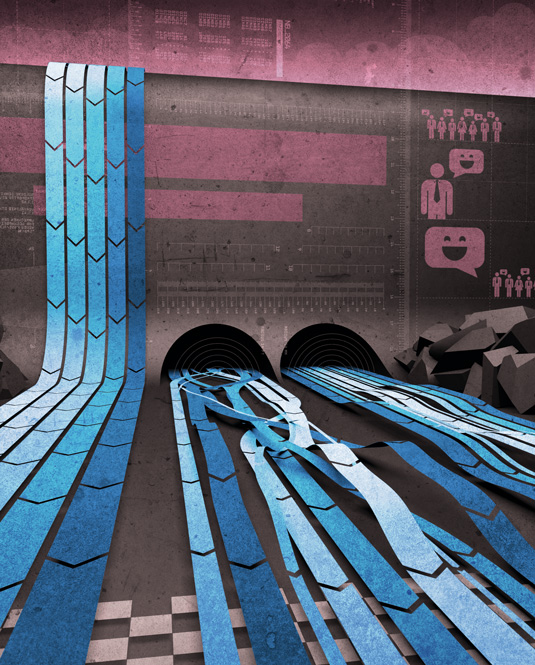4 design rules for branded digital experiences
Discover how to ensure your brand will engage with visitors online

The overall quality, accessibility, and dynamism of a company's digital experiences can make or break its brand. Luxury brands, in particular, know this reality all too well.
Wolf-Gordon, for example, is a design-focused B2B wallcovering company that came to the realization that not only was its website not providing a digital experience that users found worthy of engaging with, but it was also not branded well. Rather than conveying the company's focus of "designing as the driver", its website content was utilitarian and rote.
When Wolf-Gordon, a client of ours, and karlssonwilker, its design firm, analyzed the competitive landscape, they noticed that there was little that differentiated the company from its competition online.
If the brand didn't look interesting or relevant online, how well could its products lead the market?
The design team quickly went to work on improving the company's overall approach to branding, product photography, and user experience design. The design solution was a revolutionary digital experience for perusing wallcoverings online.
Rather than looking at small squares of product, as they might on a traditional ecommerce website, users now see large swatches of fabric and wallcovering patterns that they can quickly scroll and flip through like a real-life swatch book.
Modern branded experiences are only as good as their execution. For Wolf-Gordon, the foundation of its web development, and later its success, came from integrating creative insights for a branded digital experience with actual product data and user workflows to build a comprehensive website.
Daily design news, reviews, how-tos and more, as picked by the editors.

This new branded digital experience of a “Wolf-Gordon swatch book” has taken customer engagement on the site to new heights, and it also correlates with higher visitor engagement and sample requests.
Existing and prospective customers can now immediately sense what differentiates Wolf-Gordon from its group of peers because it's so much easier for them to engage with the company online.
Institutionalize methodologies
Like architecture, which is a marriage of design and engineering, digital design and development is both an art and a science. Creating an appealing, high-performing, and interactive digital representation of a brand requires tight collaboration between a company's design and technology teams and a clear focus on iterative, agile development principles.
Beyond just luxury brands, these approaches are becoming table stakes across all sectors as the implementation of intuitive, digital experiences becomes key to branding and business success.

Designers at all levels should familiarize themselves with the basics of leading software development methodologies to improve their knowledge of how top digital experiences are created.
It's not just web traffic analytics that are affected; many other brand and business metrics will suffer from a substandard approach to creating branded digital experiences.
Get everyone on board
Like Wolf-Gordon, companies can improve customer engagement and bottom lines by ensuring that everyone is on board to help design and develop stellar branded digital experiences. A company's team members and all of its departments — not just its web developers — will benefit from a familiarity with these various approaches and tools.
A solid understanding of rapid prototyping, material design techniques, and new development methodologies offers a more comprehensive view of the latest trends in software development.
While software development and testing will always be somewhat tedious by nature, iterative agile operations can significantly streamline the process of creating something great. With teams of developers, designers, and other stakeholders all working toward shared goals of developing excellent, compelling, and engaging websites, entire enterprises can enjoy increased efficiency and profitability.
Here are four principles that should drive creating branded digital experiences within organizations:
01. Web software is never finished
Modern web software development is a series of iterative sprints (or work cycles) that are reviewed by design and development teams at specific project milestones for validation and prioritization. Business stakeholders across the board are beginning to understand that software releases are rarely final — if ever — and ongoing updates can and should be expected.
Reusing (or leveraging by reusing) existing design and software assets, such as website modules, templates, and user interface components, not only simplifies software development projects, but it also reduces risk levels and overhead costs.
Design teams are better able to concentrate on refinements when they're working within a well-oiled machine where the collective mindset within all departments supports the creation of a seamless and dynamic digital experience. Plan for a phased design and development cycle. Know that the overall experience will evolve in the future, and be ready to support that evolution.
02. Be more agile and lean

For more than a decade, agile software development theories and principles have been making development easier for design teams and software more relevant for customers. This approach to adaptive enterprise software implementation can be effective for businesses of all sizes and on all platforms.
Agile scrum and lean UX methodologies focus all lines of business on creating fantastic products, rather than having designers and developers dig into the nuts and bolts of a project inside a vacuum. This higher level of visibility and accountability in the web design process often leads to exceptional outcomes for designers, developers, and project stakeholders alike.
Keeping an eye on exactly how people utilize a site during all phases of its development is also very important; analyzing user habits helps to zero in on individual design elements that can be improved or replaced entirely. This is how the very best sites achieve those “highly polished” finishes.
03. Make prototyping easier
Tools like Axure, InVision, and Balsamiq Mockups have quickly become the standards for interactive design teams. Each of these prototyping tools focuses on accurately communicating both a website's design vision and its user experience to clients while fostering greater collaboration among designers and developers.
Anyone who has used one of these tools understands just how vital it can be to have real-life interaction with the many layers of a website or web app design. Taking an iterative, prototype-heavy approach guarantees that designs are explored and understood well before they're actually implemented. This also leads to more appropriate outcomes for all project stakeholders.
04. Incorporate material design

Google is leading the way with the creation of material design, a new visual language for designers to use when creating interfaces for user interaction. This minimalist approach is not only more engaging, but it also provides a more modern and interactive experience.
If you use Google's web applications or the latest versions of Android, you are likely already familiar with this new design paradigm. From card-based design to material design, these approaches can serve your brand well by providing your website or application with a consistent, cohesive user interface.
One can only imagine how content will be translated for virtual, holographic, and other platforms in the near future to bring web design to a whole new level. The story of Jared Spool's $300 million button — in which a year's profitability was increased by said amount simply by making registration before purchase optional — provides a valuable lesson for all involved in UX design.
Questions to ask
If a company's website is failing to deliver, its leaders, marketers, and designers should ask themselves these questions:
- Do we need to focus on developing a more appealing website or web app that generates leads and drives sales by improving the overall user experience?
- Are all stakeholders up-to-date on these and other cutting-edge approaches to web development and design to lead our business to greater engagement with new and potential customers?
- Are all hands on deck and aware of how to nimbly and quickly apply their collective knowledge of these constantly evolving trends, tools, and processes?
Words: Jaron Rubenstein
Jaron Rubenstein is the founder and president of Rubenstein Technology Group, the leading technology partner for top creative firms. Brands ranging from Bloomberg to Harvard University to Wolf-Gordon have benefited from his design-led engineering focus on empowering user experience.
Liked this? Try these...
- 5 top tips to light up your brand in dark markets
- How to build an app: try these great tutorials
- Free graphic design software available to you right now!

The Creative Bloq team is made up of a group of art and design enthusiasts, and has changed and evolved since Creative Bloq began back in 2012. The current website team consists of eight full-time members of staff: Editor Georgia Coggan, Deputy Editor Rosie Hilder, Ecommerce Editor Beren Neale, Senior News Editor Daniel Piper, Editor, Digital Art and 3D Ian Dean, Tech Reviews Editor Erlingur Einarsson, Ecommerce Writer Beth Nicholls and Staff Writer Natalie Fear, as well as a roster of freelancers from around the world. The ImagineFX magazine team also pitch in, ensuring that content from leading digital art publication ImagineFX is represented on Creative Bloq.
